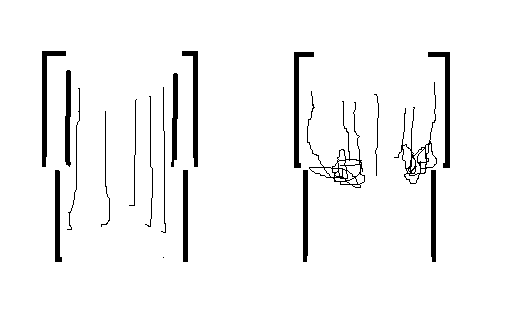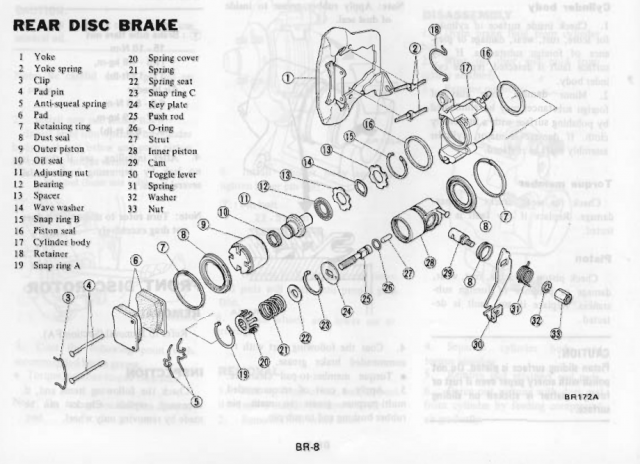
NewZed
Members-
Posts
6698 -
Joined
-
Last visited
-
Days Won
72
Content Type
Profiles
Forums
Blogs
Events
Gallery
Downloads
Store
Everything posted by NewZed
-
Rebello probably knows. Probably interested in what you're thinking of doing also, I would guess. You could call him. Here's a book that describes modifying the pump's relief pressure - http://www.amazon.com/Modify-Your-Nissan-Datsun-Engine/dp/1931128049 Forgot to say - the stock senders and gauges aren't very accurate, if that's where you're getting the "100" from. Best to verify with a directly-mounted gauge on an oil passage first.
-
If it's been sitting for long you could have dry cylinders. Low CR plus poor sealing plus old fuel = hard start. Squirt some oil in the cylinders. You might also look through the service manual. You don't seem to know the basic numbers for the system, like fuel pressure. There are tests described also for determining if your injectors are operating. Plus 30 pages of troubleshooting chart. EFEC chapter, ECCS system. http://www.nicoclub.com/FSM/280z/
-
Z's have a rod that spends most of its time under compression and has a big washer and a nut retaining the back end. ZX's have the rod in front, mostly under tension. Not sure how it's attached. What are you talking about?
-
I wonder if the Hertz or Tachometer function on a meter could do the sensing and counting. If I had a turbo EMS and was troubleshooting I think that I'd probe the various connections using one of those, with everything plugged in and connected. I've used the Hertz function to measure coil pulses, as a pseudo-tachometer. One side on the coil negative, the other to ground. Might work the same on the CAS and/or ECU output. The OP didn't say what kind of CAS he's working with. Apparently, the 81's are generally problematic.
-
There is some excellent stuff on classiczcars about using and wiring the Honda motor. Not to send people away from HybridZ but it is just a wiper motor.
-
The Z tachs are kind of sensitive to the signal they get. There's a 2300 ohm resistor in the circuit to the tachometer so they don't need much. I had a GM HEI module setup with a ZX coil that would only quiver the tach needle until I added a capacitor (typical alternator condenser) to the negative side of the coil. It worked fine then. Might be worth a try. It's cheap and won't hurt. Forgot to say though, that with 8 cylinders instead of 6 it won't read right anyway. Edit - before too much fiddling you might consider making something like this work and get it all done at once - http://www.technoversions.com/
-
Disconnect the stock Transistor Ign. at the module, not at the coil. Otherwise the HEI module may not be able to break the circuit to get a spark. That's one possibility. It's possible to test the ECU output also. The yellow/white wire should have off-on voltage when the engine is turning, if it's getting a good CAS signal. People have also described ways to test the CAS.
-
Turn Signal wiring NIGHTMARE!
NewZed replied to DatsunZman04's topic in S30 Series - 240z, 260z, 280z
You didn't mention the year, or even 240, 260 or 280. Here are a couple of starting points. http://www.atlanticz.ca/index.php/tech-tips.html http://www.xenons30.com/reference.html -
Make sure the tight side of the timing chain is tight and the damper timing mark is at zero.
-
You're spinning your wheels down a bunch of dead ends. Get the FSM, and the Fuel Injection Guidebook, and read a few pages. EFEC chapter in the FSM, and use the 1980 Guidebook. It's close enough probably for 1983, I don't think the wring changed much. Check the FSM wiring to be sure. Don't assume things, and don't jump to conclusions. Test parts before replacing them Your coil was probably fine and you wasted money on the MSD Blaster coil. You'll need a meter to measure resistance, to do the testing correctly. http://www.xenons130.com/reference.html
- 3 replies
-
- Ignition Coil
- MSD
-
(and 2 more)
Tagged with:
-
The dyno variability, and Rebello numbers, has come up before - Post #8 starts it http://forums.hybridz.org/topic/104581-twin-cam-l6-34l/
-
The light itself may be controlled by the ECU since the trigger point would be temperature dependent. The ECU would use the signal from the water temperature sender to determine when to turn on the light. The temperature sender is typically in the the thermostat housing.
-
1983 Datsun Driving Me Insane
NewZed replied to OldZNewLife's topic in Trouble Shooting / General Engine
The computers don't reset on those old cars. Whoever Tom is, he might be a nice guy,but he doesn't know anything about your car. You said that timing chain was correctly installed but you didn't mention the notch and groove. You might be looking at the wrong things on the timing chain to determine correct installation. It's been said that the L6 can warp a head after one overheat. You described many. Have you checked the plugs for coolant or pressure leakage? A cylinder pressure test would tell you if things are right or not. ThE 280ZX FSM's should be close enough to the L24E engine to help you out. Check Engine Mechanical and Engine Fuel and Emissions Control. The 1981 Fuel Injection Guide is good also. http://www.nicoclub.com/FSM/280z/ http://www.xenons130.com/reference.html Edit - could also be something simple like firing order. These engines will run with the wires placed in reverse, on just the two or three cylinders that fire. Best to confirm the basics. And this part sounds like you have your vacuum advance line connected to full time vacuum instead of ported. " the car would idle at 20 degrees, then drop down to 0 when you gave it gas". Basics. -
NA 3.1L=>head & camshaft questions. No shortcuts, max
NewZed replied to zredbaron's topic in Nissan L6 Forum
Some people get pissed and vindictive if they feel insulted. You might be hurting the cause with the e-mail. Just saying, unintended consequences. You could make the point with a reference to people you know, who are anonymous for protection. Put the onus on your trust in his words, rather than passing it to him, indirectly. -
No, the other 240, 260, 280.. sub-forum is. It says so right at the top. "A forum where members can post pictures and descriptions of progress on their project cars." This one is more for discussing specific topics or questions. That's why it's under "Technical". Here's a good one for your body shop question - http://forums.hybridz.org/forum/13-body-kits-paint/ And the second link just sets a few ground rules to keep the site organized and neat. It helps the thought processes.
-
You should put all of your pictures here - http://forums.hybridz.org/forum/57-s30-series-240z-260z-280z/ And keep your topics isolated to separate threads. And title the thread with informative words. You asked for a body shop in two threads but neither thread title says anything about it. It'll help you get some responses. The first four pinned threads in this link are important too. http://forums.hybridz.org/forum/68-new-members-forum/
-
Did you see the threads about swapping the engine? In this sub-forum, the one you're posting in? Thought the links would lead you there. Not really clear what more you're asking. Good luck. Samples - http://forums.hybridz.org/topic/111097-mckinney-motorsports-vh45de-s30-swap/ http://forums.hybridz.org/topic/107948-vh45-swap-anybody/ http://forums.hybridz.org/topic/111991-vh45-240z-oil-filter-clearance-fail/
-
Several threads in this sub-forum. http://en.wikipedia.org/wiki/Nissan_VH_engine#VH45DE http://en.wikipedia.org/wiki/Infiniti_Q45
-
The site below should have what you need to do in-depth diagnosing. The 1980 Fuel Injection Guide and the Engine Fuel chapter of the FSM, plus the Electrical chapter. Proper specs. are in there also, like ~36 psi for the fuel pressure, for a non-running engine. http://www.xenons130.com/reference.html
-
Why did it sit for 5 years? Seems like every Z or ZX you see for sale "ran when parked". But no one ever says why they parked it in the first place. Since you've had a bunch of parts off, the best place to start is to make sure that everything has been replaced correctly. Check firing order and rotation direction (common to get wrong), check fuel pressure (hoses connected backward), check that the blue wire from the coil negative to the ECU is still attached (does the tachometer work when cranking?), etc. And, if you have spark, the common way to check many of the above at one time is to use starting fluid. If the engine starts, sounds right, but dies, then you can focus on getting the injectors to deliver fuel. Are you sure that you're hearing the fuel pump? Could be the power antenna.
-
L28ET swap 240z runs rough won't take throttle
NewZed replied to motomanmike's topic in Nissan L6 Forum
Why are you worrying about electrical and fuel blockages when the 30 psi reading tells you those probably aren't issues? Take more pressure readings, ideally while the problem is happening. You haven't taken the most basic reading for the fuel system yet either, with the vacuum hose removed from the FPR. Or maybe you have, but your description left it out. Looks like you took a reading with the engine running at idle, and it's in-range. http://www.nicoclub.com/FSM/280z/ http://www.xenons130.com/reference.html -
Actually, I was kind of harsh. Doesn't really matter that he's British, and he likes cool-looking cars. Nothing wrong with that. He did say himself though, that he was clueless. But if that's the Rocky Auto yard that the blue car is sitting in, their shop looks terrible. Piles of car parts laying everywhere. Doesn't help the mystique. rturbo930 deleted his youtube link for some reason, but supplied another that shows the same car at a show.
-
Obstructions at the edges of flow are the main problem you might have. The liners exit inside the edges of the exhaust manifold. Without the liner you might get turbulence and flow obstruction. Put a gasket on the head and you'll see how bad it might be.
-
The video is just some clueless British guy selling match box car's from his bedroom. Looks like he still lives with his parents. The video gets worse and worse as it goes on.
-
'82 280zx rear brake caliper rebuild question
NewZed replied to tamo3's topic in Brakes, Wheels, Suspension and Chassis
1979 and 80 look like they have the star-shaped spacers. But they use a snap ring, not the wire ring you show.

